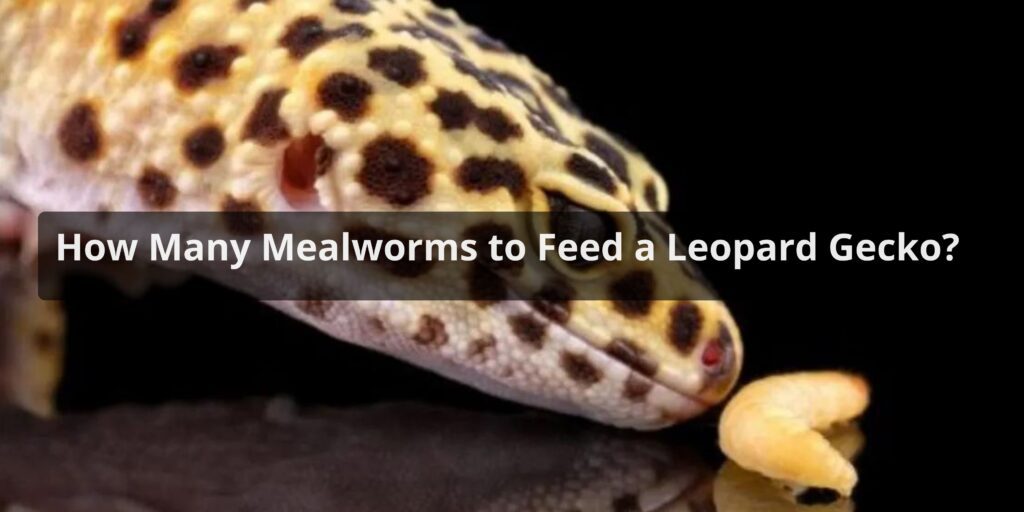Determining the right amount of mealworms to feed a Leopard Gecko can seem complicated for new owners. Leopard geckos are insectivores, meaning insects make up the bulk of their diet. Mealworms are a common feeder insect used for leopard geckos and provide good nutrition. However, overfeeding mealworms can lead to health issues while underfeeding can lead to malnutrition. Finding the right balance is important.
Key Factors to Consider

When deciding how many mealworms to feed a leopard gecko, there are a few key factors to take into account:
The Gecko’s Age
Younger leopard geckos under 1 year old need more frequent feedings to fuel growth. They can be fed daily and generally eat more per feeding than adults. Adults over 1 year only need to be fed 2-3 times per week.
The Gecko’s Size
Larger, heavier geckos will need more mealworms than smaller, lighter ones. A good rule of thumb is to feed approximately 1-2 mealworms per inch of body length.
Activity Level
Leopard geckos that are more active will burn more energy and require more food. Less active geckos may eat slightly less. Monitor activity patterns.
Life Stage
Geckos that are growing, egg-laying females, or geckos recovering from illness will need more food than those that are maintaining weight as adults. Adjust amounts accordingly.
Individual Needs
Every leopard gecko is unique. Pay attention to your individual gecko’s hunger cues. Some are heartier eaters than others. Feed according to their interest in food at each meal.
Recommended Feeding Guidelines
Taking the above factors into account, here are some general guidelines for how much to feed leopard geckos at different life stages:
- Hatchlings under 6 months: Feed daily, providing as many mealworms as they will eat in a 10-15 minute period. Start with 10-15 worms and adjust amounts based on appetite.
- Juveniles 6-12 months old: Feed daily, providing 15-20 mealworms per day.
- Adult geckos over 1 year old: Feed 2-3 times per week, providing around 6-10 mealworms at each feeding, depending on size. Larger adults may eat up to 15 worms per feeding 2-3 times a week.
- Gravid (egg-laying) females: Increase feeding to 3-4 times per week and provide additional food, up to 25% more than typical amounts.
- Underweight geckos: Gradually increase portions and frequency until optimal weight is reached.
- Overweight geckos: Gradually decrease portions and frequency until optimal weight is reached.
These serving sizes can be adjusted as needed based on your individual gecko’s size, appetite, activity level and health status. The key is to pay close attention and tweak amounts to maintain a healthy weight and growth.
Providing Variety
While mealworms should make up a significant portion of the diet, it is also important to provide some variety for optimal nutrition. Here are some other feeder insects that can be rotated in:
- Crickets: Nutritious staple, offer similar to mealworms
- Dubia roaches: Excellent source of protein
- Waxworms: High in fat, feed sparingly as treats
- Hornworms: High in calcium, provide as supplemental feeders
Aim to have mealworms make up around 75% of feedings, with other insects making up the remaining 25% variety. This ensures a balanced diet.
Monitoring Health
Keep an eye on your leopard gecko’s health signs to determine if you are feeding the right amount. Here is what to look for:
- Good weight and body condition: Smooth, plump tail base. No sunken sides or protruding hips and spine.
- Bright, alert eyes and activity: Active, healthy geckos will explore regularly.
- Regular bowel movements: Look for expected urates (white tips on feces) indicating proper digestion.
- Healthy skin and shedding: No signs of irritation, discharge or retained shed skin.
- Normal feeding behavior: Strong appetites when food is offered.
Make adjustments if you notice signs of overfeeding (obesity) or underfeeding (weight loss, lethargy). Aim to maintain an optimal, healthy body condition.
Conclusion
Determining the right number of mealworms to feed leopard geckos requires taking into account the gecko’s age, size, and activity level. Use the feeding guidelines provided and tweak amounts based on your individual gecko’s needs. Aim for around 75% mealworms mixed with 25% other insect feeders for variety. Monitor your gecko’s health and adjust portions to maintain a proper body weight and nutrition. With some fine tuning, you can determine the ideal mealworm amounts to feed your leopard gecko.
FAQs
Should I vary the number of mealworms based on the age of my leopard gecko?
Yes, you should adjust the number of mealworms based on your leopard gecko’s age. Juvenile geckos require more frequent feeding, so offer them a higher quantity of mealworms compared to adults. Gradually decrease mealworms as they mature to prevent overfeeding.
Do mealworms provide all the necessary nutrients for leopard geckos?
Mealworms alone do not provide all the essential nutrients for leopard geckos. While they are a suitable part of their diet, you should diversify their food with other insects like crickets, dubia roaches, and occasional treats. This variety ensures a balanced nutrient intake.
Are there any health risks associated with feeding too many mealworms to leopard geckos?
Feeding an excess of mealworms can lead to health risks for leopard geckos. They have a high-fat content and a suboptimal calcium-to-phosphorus ratio. Over time, this can result in obesity and metabolic bone disease. Maintain a balanced diet to mitigate these risks.
Can I use mealworms as the primary food source for my leopard gecko?
While mealworms can be a part of a leopard gecko’s diet, they should not be the primary food source. Using mealworms exclusively can lead to nutritional deficiencies. A varied diet that includes different insects ensures your gecko receives all the required nutrients.
Are there alternative insects besides mealworms that I should include in my leopard gecko’s diet?
Yes, it’s crucial to include a variety of insects in your leopard gecko’s diet. In addition to mealworms, consider offering crickets, dubia roaches, waxworms, and phoenix worms. This diversity provides a wider range of nutrients and prevents dietary monotony.



